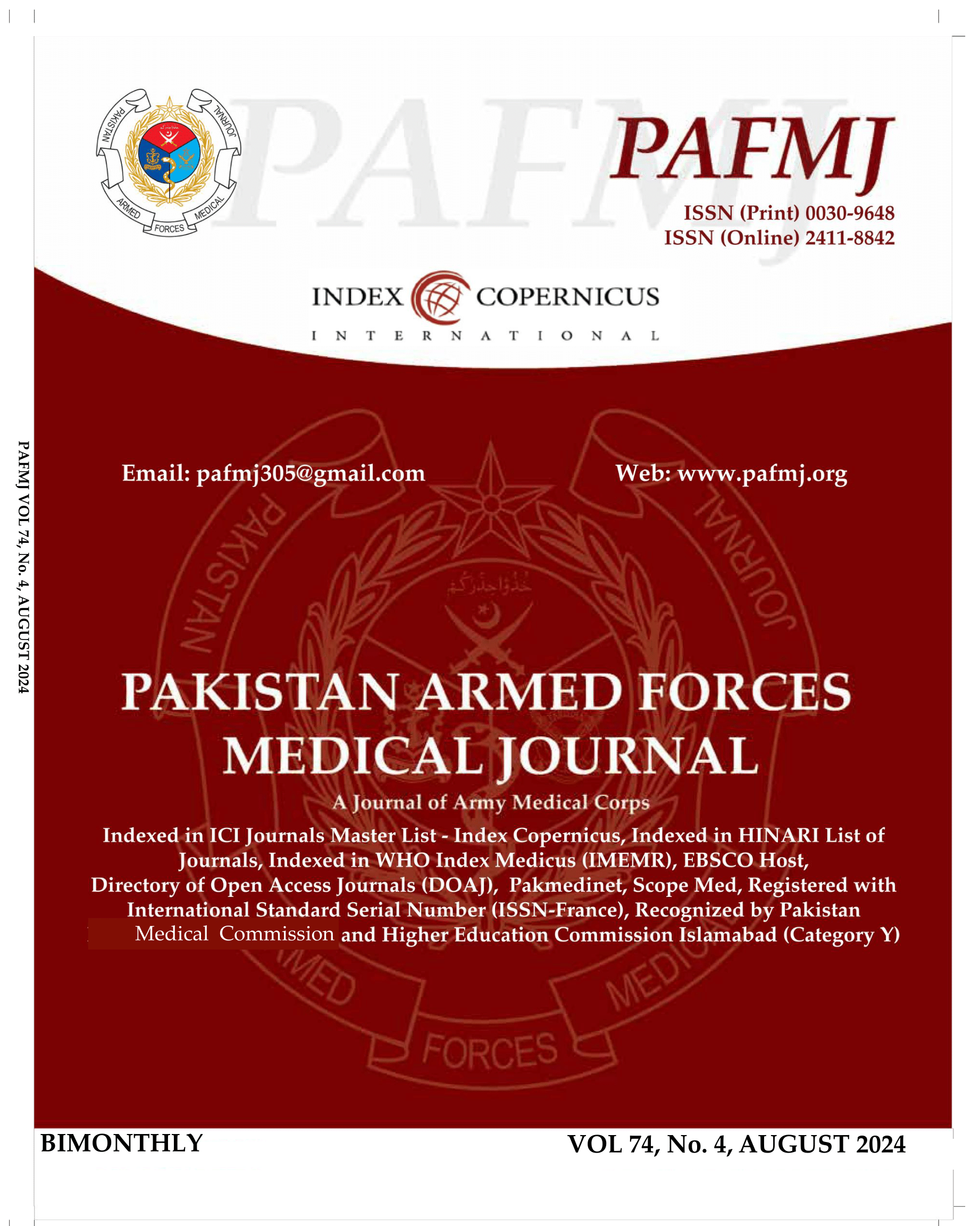Comparison of Post-Operative Analgesic Requirement in Patients undergoing Hemorrhoidectomy Under Caudal Epidural Anaesthesia Versus Saddle Anaesthesia
DOI:
https://doi.org/10.51253/pafmj.v74i4.7877Keywords:
Caudal epidural anaesthesia, Hemorrhoidectomy; pain; Saddle anaesthesiaAbstract
Objective: To compare post-operative analgesic requirements in patients undergoing hemorrhoidectomy under caudal epidural anaesthesia versus saddle anaesthesia.
Study Design: Quasi Experimental Study.
Place and Duration of Study: Combined Military Hospital, Rawalpindi Pakistan, Feb to Nov 2021.
Methodology: The study was conducted on 200 patients who underwent hemorrhoidectomy during the study period. Patients were randomized into two groups. Group-A received caudal epidural anaesthesia, while Group-B received saddle anaesthesia. The pain at the surgical site was recorded on a visual analogue scale 04 hours and 08 hours after the surgical procedure. The difference in significant post-operative pain and the requirement of opioid analgesia was compared.
Results: Out of 200 patients randomized into two groups, 96(48%) were categorized into Group-A, and 104(52%) were categorized into Group-B. The mean age of patients who were operated for hemorrhoids in our study was 41.56±6.98 years. Patients who received caudal epidural anaesthesia had more chances of not having significant post-operative pain at 04 and 08 hours after the surgery as compared to those who received saddle anaesthesia (p-value<0.05). The requirement of opioid analgesia at 02 hours was also statistically significantly less in these patients as well (p-value<0.05).
Conclusion: The Use of caudal epidural anaesthesia during the haemorrhoidectomy emerged as better management for early post-operative pain as compared to the use of saddle anaesthesia. The requirement for opioid analgesia was higher in patients after two hours of surgery who received saddle block than those who were administered caudal epidural anaesthesia.
Downloads
References
Hiller DJ, Chadi SA, Rosen L, Wexner SD. Consequences of Increasing Complexity in Anorectal Surgery Performed at an Academic Center. Dis Colon Rectum 2019; 62(3): 343-347. https://doi.org/ 10.1097/DCR.0000000000001204
Malik AA, Afzal MF, Majid HJ, Syed AA, Khattak S, Muhammad Y, et al. Clinical Practice Guidelines for The Management of Colorectal Cancer, A Consensus Statement by The Society of Surgeons® And Surgical Oncology Society of Pakistan®. J Pak Med Assoc 2021; 71(Suppl 6) (10): S1-S7.
Mohammad S, Rind GH, Shah IA, Baloch I, Shah AA, Lakho S, et al. Colonoscopy Findings: A Single Institution Study from Pakistan. Cureus 2019; 11(11): e6167.
https://doi.org/10.7759/cureus.6167
Majeed MH, Nadeem R, Khokhar MA, Qaisar MN. Adequacy of Pain Control in Patients with Advanced Cancer in Pakistan. J Palliat Care 2019; 34(2): 126-131.
https://doi.org/10.1177/0825859718800490
Hamza M, Dionne RA. 2020 Foresight: Envisioning Therapeutic Innovations for Pain. Drug Discov Today Ther Strateg 2009; 6(3): 113-119. https://doi.org/10.1016/j.ddstr.2010.10.002
Eroglu A, Apan A, Erturk E, Ben-Shlomo I. Comparison of the Anesthetic Techniques. Sci World J 2015; 2015: 650684.
https://doi.org/10.1155/2015/650684
Simsek T, Saracoglu A, Zenigin U, Yilmaz M, Saracoglu KT. Regional Anesthesia for Anorectal Surgeries: What is the Best Solution? S Clin Ist Euras 2021; 32(2): 195-200
Bozkurt C, Erturk E, Akdogan A, Kesicioglu T, Aydin I. Comparison of spinal versus caudal epidural anesthesia in the management of patients undergoing ambulatory perianal surgery: Randomized, prospective study. J Clin Med Kaz 2021; 18(5): 76-81.
Shaw D, Ternent CA. Perioperative Management of the Ambulatory Anorectal Surgery Patient. Clin Colon Rectal Surg 2016; 29(1): 7-13.
https://doi.org/10.1055/s-0035-1570023
Hashmi SMM, Nasir S, Shehbaz I, Anwar MA, Ali A. Outcome of local anesthesia in pain relief after hemorrhoidectomy.
Biomedica 2016; 32(1): 18-20.
Medina-Gallardo A, Curbelo-Peña Y, De Castro X, Roura-Poch P, Roca-Closa J, De Caralt-Mestres E. Is the severe pain after Milligan-Morgan hemorrhoidectomy still currently remaining a major postoperative problem despite being one of the oldest surgical techniques described? A case series of 117 consecutive patients. Int J Surg Case Rep 2017; 30: 73-75.
https://doi.org/10.1016/j.ijscr.2016.11.018
Genova P, Damiano G, Lo Monte AI, Genova G. Transanal hemorrhoidal dearterialization versus Milligan-Morgan
hemorrhoidectomy in grade III/IV hemorrhoids. Ann Ital Chir 2019; 90: 145-151.
Xu D, Xiu M, Zhang X, Zhu P, Tian L, Feng J, et al. Effect of dexmedetomidine added to ropivicaine for caudal anesthesia in patients undergoing hemorrhoidectomy: A prospective randomized controlled trial. Medicine 2018; 97(34): e11731.
https://doi.org/10.1097/MD.0000000000011731
Maryam A, Sajjad H. Saddle Anesthetic Block. Treasure Island (FL): StatPearls Publishing; 2021.
Shon YJ, Huh J, Kang SS, Bae SK, Kang RA, Kim DK. Comparison of saddle, lumbar epidural and caudal blocks on anal sphincter tone: A prospective, randomized study. J Int Med Res 2016; 44(5): 1061-1071.
https://doi.org/10.1177/0300060516659393
Vadhanan P, Rajendran I, Rajasekar P. Ultrasound-Guided Caudal Epidural Anesthesia in Adults for Anorectal Procedures. Anesth Essays Res 2020;1 4(2): 239-242.
https://doi.org/10.4103/aer.AER_60_20
Gianakos AL, Romanelli F, Rao N, Badri M, Lubberts B, Guss D, DiGiovanni CW. Combination Lower Extremity Nerve Blocks and Their Effect on Postoperative Pain and Opioid
Consumption: A Systematic Review. J Foot Ankle Surg 2021; 60(1): 121-131.
https://doi.org/10.1053/j.jfas.2020.08.026
Siddiqui ZI, Denman WT, Schumann R, Hackford A, Cepeda MS, Carr DB. Local anesthetic infiltration versus caudal epidural block for anorectal surgery: a randomized controlled trial. J Clin Anesth 2007; 19(4): 269-273.
Downloads
Published
Issue
Section
License
Copyright (c) 2024 Waqas Tariq, Ahmed Sarfaraz, Hamza bin Tariq, Muhammad Asad Sultan Khan, Manzar Abbas Shah Naqvi, Khalid Buland

This work is licensed under a Creative Commons Attribution-NonCommercial 4.0 International License.















